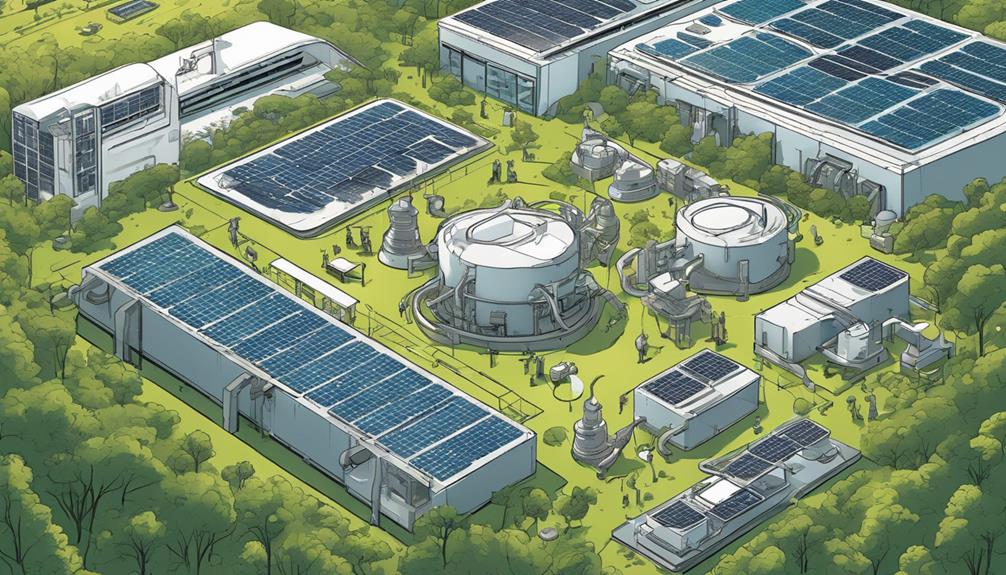EnergyX's breakthrough in lithium extraction is transforming the industry with its innovative LiTAS™ technology. You'll find that this cutting-edge method achieves over 90% recovery rates from brine in just days, outperforming traditional techniques by 300%. Not only does it expedite lithium production to meet growing demands for electric vehicles and smartphones, but it also minimizes environmental impact by conserving water and avoiding harsh chemicals. Strategic partnerships, like those with General Motors, further enhance the lithium supply chain. If you're curious about the implications and future of this technology, there's much more to explore.
Key Takeaways
- EnergyX's LiTAS™ technology achieves over 90% lithium recovery from brine, significantly enhancing extraction efficiency compared to traditional methods.
- The innovative technology produces 300% more lithium output while minimizing environmental impact and conserving water resources.
- Strategic partnerships, including collaborations with General Motors, aim to address lithium shortages and strengthen the supply chain.
- EnergyX's focus on sustainable practices positions it as a leader in the rapidly growing lithium market driven by electric vehicle demand.
The Rising Importance of Lithium

Lithium's skyrocketing demand is reshaping industries, making it essential for everything from your smartphone to electric vehicles. As you rely on faster-charging, longer-lasting lithium-ion batteries, the need for lithium is more pressing than ever.
By 2040, experts project a 20-fold increase in demand, opening up significant market opportunities. The lithium market could reach a staggering $546 billion by 2035, drawing attention from entrepreneurs and investors alike.
With major players like Elon Musk highlighting its profitability, you see fierce competition for lithium supply, particularly between the U.S. and China. To meet the growing electric vehicle demand, the U.S. will need at least 500,000 tons of lithium annually by 2034, underscoring the strategic importance of securing domestic sources.
EnergyX's Innovative Extraction Technology

EnergyX is revolutionizing lithium extraction with its cutting-edge Lithium Ion Transport and Separation (LiTAS™) technology, which boasts over 90% recovery rates from brine in just days.
This innovative method outperforms traditional techniques, achieving 300% more output and dramatically speeding up the production process.
By utilizing a unique blend of adsorbents, solvents, and membranes, LiTAS™ provides tailored solutions that enhance efficiency.
You'll appreciate that this approach not only maximizes recovery but also minimizes environmental impact, as it avoids harsh chemicals and conserves water.
EnergyX's pilot plant in the Lithium Triangle demonstrates the exceptional capabilities of LiTAS™, positioning North America to become a significant player in the lithium market.
This technology could reshape the future of lithium extraction for sustainable energy.
Environmental Benefits of LiTAS

By adopting LiTAS™ technology, companies can greatly reduce the environmental impact of lithium extraction while maximizing recovery efficiency. This innovative process minimizes water usage and avoids harsh chemicals, making lithium extraction cleaner and more sustainable.
Unlike traditional methods, which can disrupt ecosystems and deplete local water resources, LiTAS™ operates efficiently and responsibly. You'll see over 90% lithium recovery within days, ensuring that resources are utilized to their fullest potential.
By choosing LiTAS™, you're not just boosting productivity; you're also committing to environmental stewardship. This technology paves the way for a greener future, supporting the demand for lithium while protecting our planet.
Embracing LiTAS™ means aligning with sustainable practices essential for today's energy landscape.
Strategic Investments in Lithium

Investing strategically in lithium production is essential for securing a sustainable future in electric vehicle manufacturing and other advanced technologies.
You'll find that major companies like General Motors are already stepping up, investing millions in firms like EnergyX to guarantee a robust lithium supply chain. These investments not only aim to enhance lithium extraction methods but also support the development of advanced battery technologies.
By getting involved, you can tap into a growing market projected to surge in demand over the coming decades. As you consider investment opportunities, know that supporting innovative companies positions you at the forefront of the lithium revolution, contributing to both economic growth and environmental sustainability.
Don't miss this chance to be part of the future!
Partnerships Driving Supply Chain Changes

Strategic partnerships are reshaping the lithium supply chain, ensuring a more efficient and sustainable approach to meeting the soaring demand for this critical resource.
Companies like EnergyX and General Motors are joining forces to tackle the lithium shortage head-on. By investing in direct lithium extraction technologies, they're enhancing production capabilities while minimizing environmental impact.
These collaborations foster innovation and streamline processes, making it easier for you to access the lithium needed for electric vehicles and renewable energy solutions.
Additionally, partnerships with local suppliers help reduce reliance on foreign sources, bolstering national security.
As these alliances grow, you can expect a more resilient and responsive lithium supply chain that addresses both current and future demands effectively.
Entrepreneurial Success in Lithium Sector

Entrepreneurs are seizing the booming opportunities in the lithium sector, driving innovation and sustainability in a market poised for explosive growth.
As demand for lithium skyrockets due to electric vehicles and renewable energy, you'll find a landscape ripe for entrepreneurial ventures.
Companies like EnergyX are leading the charge with groundbreaking technologies, revolutionizing how lithium is extracted and produced.
This innovation attracts significant investments and partnerships, creating a dynamic ecosystem for new startups.
By focusing on sustainable practices and addressing supply chain challenges, you can position yourself at the forefront of this industry.
The potential for success is monumental, and those who act now can capitalize on the lithium revolution and contribute to a greener future.
Trends Shaping the Lithium Market

The lithium market is rapidly evolving, driven by increasing demand for electric vehicles and sustainable energy solutions.
You're seeing a significant shift as automakers prioritize lithium-ion batteries for their efficiency and longevity. Furthermore, the push for renewable energy storage is intensifying, further boosting lithium's importance.
Countries are competing to secure lithium supplies, with the U.S. aiming for self-sufficiency to reduce reliance on foreign sources.
Technological advancements, like EnergyX's innovative extraction methods, are revolutionizing production efficiency, minimizing environmental impact.
In addition, investment in lithium ventures is surging, attracting attention from major players and entrepreneurs alike.
As these trends converge, the lithium market is set to play a critical role in the global shift to cleaner energy.
Future Outlook for Lithium Production

With the lithium market poised for explosive growth, the future of lithium production looks promising as innovations and investments reshape the landscape.
You'll see companies like EnergyX leading the charge with advanced extraction technologies that greatly boost recovery rates.
As demand for electric vehicles and renewable energy solutions skyrockets, major players are investing heavily to secure lithium supplies.
Partnerships, like the one between EnergyX and General Motors, are essential for transforming the North American lithium supply chain.
Additionally, the push for sustainable practices will drive the industry forward, ensuring both economic viability and environmental responsibility.
If you're looking to invest or engage in this booming sector, now's the time to get involved.
Conclusion
As you explore EnergyX's breakthroughs, you'll see how innovative extraction methods, sustainable practices, and strategic partnerships are reshaping the lithium landscape.
You'll recognize the urgency of meeting skyrocketing demand, the potential for environmental benefits, and the entrepreneurial spirit driving this revolution.
By embracing these advancements, you not only contribute to a sustainable future but also stand at the forefront of an industry poised for growth.
Together, let's harness the power of lithium for a cleaner, greener tomorrow.









